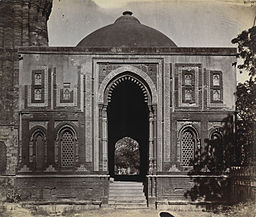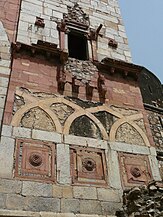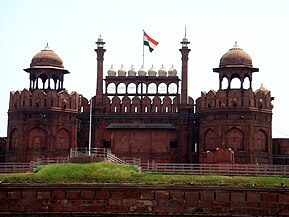Gates of Delhi
The Gates of Delhi were city gates at various medieval townships around Delhi, built under dynastic rulers in the period that could be dated from the 8th century to the 20th century. They are the gates in:
- The ancient city of Qila Rai Pithora or Lal Kot, also called the first city of Delhi (period 731–1311) in Mehrauli – Qutb Complex
- The second city of Siri Fort (1304)
- The third city Tughlaqabad(1321–23);
- The fourth city of Jahanpanah (mid-14th century)
- The fifth city of Firozabad (1354)
- The sixth city of Dinpanah/Shergarh (1534), near Purana Qila
- The seventh city Shahjahanabad (mid 17th century)
- The eighth modern city New Delhi, built in the 1920s during the British rule
In 1611, the European merchant William Finch[1] described Delhi as the city of seven castles (forts) and 52 gates. More gates were built after that period during the Mughal rule and during the British rule. Only 13 gates exist in good condition, while all others are in ruins or have been demolished. Like all gates denote, the direction of the destination station is the starting name of the gate.[2][3][4][5][6][7]
Gates in the 1st city
In the first city of Delhi, 13 gates were built in the 11th-century citadel of
The Chaumukha Darwaza (Chaumukha in
The Ranjit gate towards the north wall of Lal Kot is in ruins. It was once considered as a grand gate through which the Turks had entered the city. Hence, it was subsequently fortified to prevent any further foreign incursions. Only part of the gate is visible and is yet to be listed as a heritage monument.[2]
The Fateh Gate close to Fateh Burj has convoluted features and is about 24 m (79 ft) in diameter. The Sohan Gate guarded by a large bastion called the Sohan Burj was stated to be the location of a Sun temple.[2]
Hauz Rani and Budayuni Gates, which were reportedly once-prominent gates, are now traced in ruins. An anecdote of history of the Budayuni gate, considered then as the principal gate of the city by
"The Alai Darwaza is not only the most beautiful structure at the Kutub, but is one of the most striking specimens of external polychromatic decoration not merely in India, but in the whole world, while the carving of interior may challenge comparison with any work of the kind. Both exterior and interior merit detailed and leisurely examination. The effect of the graceful pointed arches in the three external sides of the gate, and in the corner recesses is extremely pleasing, and the view from the exterior through the southern archway to the round-headed arch of the north side, and the court beyond, is very striking. The decoration of the north arch is curious and unique. The effect of exterior suffers, from a distant point of view, from the absence of a parapet above the walls; this was unfortunately removed by Captain Smith, as it was greatly ruined. The gate was finished five years before the emperor died, and is specially mentioned by the chronicler of his reign."'
Gates in the 2nd city

The second medieval city of Siri Fort was built during the rule of Ala-ud-Din Khalji of the Delhi Sultanate with the major objective of protecting the city from the onslaught of the Mongols.[14][15] The city, when built with an oval plan, was best described as presenting an embodiment of richness with palaces and other structures and had seven gates for entry and exit. But, at present, only the Southeastern gate exists, also in ruins (pictured). The destruction of the fort and its gates are attributed more to the local rulers of subsequent dynasties who removed the stones, bricks and other artifacts of the fort for their own buildings and palaces.[16]
Gates in the 3rd city
Gates in the 4th city
Muhammad bin Tughluq, first built Adilabad, then Nai-ka-Kot, towards the south of Tughlaqabad. These were two small fortresses. But he soon abandoned them. He built a new city by enclosing the areas lying between the cities of Siri, Tughlaqabad and Lal Kot. The city was named as Jahanpanah, an asylum of the world, in 1334. The city had 13 gates. The ruins of gigantic ramparts of his two fortresses and some portions of the Jahanpanah walls have survived the ravages of time but are seen now only in total ruins. The watchtower Bijai Mandal still stands in ruins in the city of Jahanpanah. But no fort gates are traced.[14][19]
Gates in the 5th city
Gates in the 6th city
Three main gates on the north, south and west are part of the fortifications of the

Sher Shah Gate

Sher Shah gate located to the south of Khairu’l-Manazil-Masjid is said to be an entrance to the large city of Delhi that Sher Shah built in front of his fortress of Purana Qila. The gate, mostly built with red sandstone but with use of local
Gates in the 7th city
The names of the wicket gates or windows (now none exist) through which people entered and exited from the old fort city were:
- Zeenatul Masajid Khirkee
- Nawab Ahmad Bakhsh ki Khirkee
- Nawab Ghaziuddin ki Khirkee
- Musamman Burj ki Khirkee
- Muslim Garh ki Khirkee
- Naseer Ganj ki Khirkee
- Nai Khirkee
- Shah Ganj Khirkee
- Ajmeri Darwaza ki Khirkee
- Sayyad Bhole ki Khirkee
- Buland Bagh ki Khirkee
- Farash Khana ki Khirkee
- Ameer Khan ki Khirkee
- Khalil Khan ki Khirkee
- Bahadur Ali Khan ki Khirkee
- Nigambodh ki Khirkee.
Kashmiri gate
Delhi Gate

The Delhi Gate (Coordinates 28.641196N 77.240511E) is the southern gate in the historic
Ajmeri Gate

Ajmeri Gate, built in 1644, to the south–west of Shahjahanabad with a square plan, has high arched openings. It was one of the battlefields of the
Turkman Gate

Turkman Gate, located to the southern edge of Shahajahanabad (Coordinates: 28.642231N 77.232591E), is named after the
Lahori Gate, Old Delhi

The Lahori gate of the Old Delhi city (Coordinates: 28.657110N 77.218831E), now only a bazaar square with small remnants at one end, used to lead east along the Chandni Chowk to the Lahore gate of the Red Fort. Inside the Lahori gate is the grain market. Outside the gate stands a mosque built by Sirhindi Begum, wife of Shah Jahan, whom he married after the death Arjumand Banu Begum, Mumtaz Mahal. This Lahori Gate was also one of the last points captured during the siege of 1857.[28]
Lahore Gate, Red Fort
The Lahore gate (Coordinates: 28.655879N 77.238666E) is the main gate to the Red Fort named after its orientation towards Lahore, Pakistan.[6][7][25][29][30]
Delhi Gate, Red Fort
The southern public entrance to the Red Fort (Coordinates: 28.652148N 77.240112E).
Nigambodh Gate
It was built on the north eastern side of the
Khooni Gate

Kabuli Gate or Khooni Darwaza (Coordinates: 28.635974N 77.241042E), literally translated means "Bloody Gate", a "morbid sounding name". It is a double–storied structure. Its construction is credited to Sher Shah Suri's reign from 1540 to 1545 (though the fort walls of the Suri period have not been seen to extend to this gate). It was built largely with grey stone but red stones were also used in the frames of its windows.[4][9][29] Though not within the walls of the Shahajahan's fort, it is located on the Mathura road opposite to the
Bahadur Shahi Gate
Salimgarh Fort, which is now part of the Red fort complex, was constructed on an island of the Yamuna River in 1546. But a gate called the Bahadur Shahi Gate for entry into the Fort from the northern side was constructed only in 1854–55 by
Gates in the 8th city
Delhi became the capital of
Gallery
-
Ancient view of Alai Darwaza
-
South gate entry to Tughlaqabad Fort
-
West gate ofFirozabad
-
South Gate Purana Qila
-
North gate Purana Qila
-
Lal Darwaza detail
-
Red Fort entry gate
-
Mori Gate
-
Water Gate of Red Fort
-
Delhi Gate of Red Fort
The grave to the east of Turkman Gate is not the mausoleum of the 13th century Sufi Shams-ul-Arifeen Shah Turkman Byabani. The Shrine of the Sufi is deep inside Mohalla Qabristan and can be approached either through Mohammad Deen Ilaichi Marg or through the road leading to Chitli Qabar from Turkman Gate. The grave to the east of Turkman Gate has nothing to do with the Sufi and this is some imposter who is using a lack of information on the Sufi Sanit to make some quick buck.
See also
- Gates in India
- History of Delhi
- Gates in Aurangabad
References
- ^ Finch's journal, 1608–11, was excerpted and published by Samuel Purchas, Purchas His Pilgrimes, London, 1625; the material concerning India was republished in Sir William Foster, Early travels in India, 1583-1619 (1921; reprinted 1985) pp 125–87.
- ^ a b c d e f g Basu, Arundhati (26 June 2004). "Wisps of the past through Dilli's golden gates". The Times of India. Retrieved 10 June 2009.
- )
- ^ a b c d e "Gates of Delhi". Retrieved 16 May 2009.
- ^ a b c "History of Delhi". Retrieved 16 May 2009.
- ^ )
- ^ a b c d e "Gates of Old Delhi". Retrieved 16 May 2009.
- ^ Peck p.229,236
- ^ a b c d e f g h i "Commonwealth Games-2010, Conservation, Restoration and Upgradation of Public Amenities at Protected Monuments" (PDF). Qila Rai Pithora Wall. Archaeological Survey of India, Delhi Circle. 2006. p. 55. Archived from the original (PDF) on 11 October 2011. Retrieved 29 August 2009.
- ^ Peck p.236
- ^ Peck p.42
- ^ Sharma p.57,58
- )
- ^ a b c d "Siri Fort". Retrieved 7 May 2009.
- ^ Sharama, Y.D. (2001). Delhi and its Neighbourhood. New Delhi: Archaeological Survey of India. pp. 22, 83–84. Archived from the original on 31 August 2005. Retrieved 24 April 2009.
{{cite book}}:|work=ignored (help) - ^ Peck p.
- ^ Peck p.135–138
- )
- ^ Peck p.58
- ^ Peck p.82–85
- ^ Peck p.134–138
- ^ Sharma p.122–123
- ^ Peck p.138
- ^ Sharma p.128–129
- ^ )
- ^ "Kashmeeri gate, Delhi". Retrieved 18 May 2009.
- ^ Peck p.192
- ^ a b c Hearn, p. 44
- ^ a b c d Jahan, Mahtab (2004). "Dilli's gates and windows". MG The Milli Gazette Indian Muslims leading new paper. Retrieved 17 May 2009.
- ^ Sharma p.143
- ^ "Press Release on Inscription of the Red Fort in the World Heritage List – 2007" (PDF). Archaeological Survey of India. Archived from the original (PDF) on 10 April 2009. Retrieved 28 May 2009.
- )
- )
- ^ Peck p.266,268
- ^ "India Gate". Retrieved 16 May 2009.
- ^ Peck p.276
External links
- Hearn, Gordon Risley (1906). The Seven Cities of Delhi. W. Thacker & Co., London.























